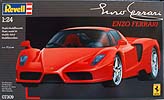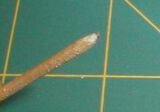|
Home
> Car
Models > Current
Projects > Revell 1/24 Enzo Ferrari > 7. Polishing












Tamiya's fine finishing paper (left) contains
very fine sand papers of one 1200 grit, two 1500 grit and two 2000 grit. It's
about 250 yen, or $3.60 retail.Detail Master's polishing cloth
set (right) contains
3200, 3600, 4000, 6000, 8000 and 12000 grit sanding abrasives.
They're also available individually. 
Eyeglass
cleaning cloth 
When polishing a
hard to reach area, put a tooth pick inside the polishing close. Cut
the tip flat, and make your own tool accordingly. |
|
Revell Germany 1/24 Enzo Ferrari
7. Polishing
|
|
|
I receive many questions about how to achieve a
mirror-like surface, so I'll explain it in detail. |
|
|
| After about eight "very light"
coats of Tamiya spray, the surface looked like this. You can see
a moderate orange peel, but as long as it's minimal, don't worry too much about adding more layers. What's
important is to apply sufficient thickness to be ready for
sanding. |
 |
| If orange peel is not so severe, you can
use 2000 grit Tamiya sand paper. Otherwise, start from 1500
grit,
and then 2000. Make sure not to over-do it, especially near
the edge. I only used 2000 grit for this model. |
 |
| Then, I used Detail Master abrasive 4000 grit,
and worked the way up to 12000 grit. After sanding with 12000 grit
cloth, the surface looked like this, and all visible scratches were gone. If there
were some, go back to a coarser sanding cloth. |
 |
| Using soft and fine cloth, such as
eyeglass cleaning cloth, gently rub
the surface with Tamiya compound or scratch remover.
I used
Meguiar's Scratch X for this model. Scratch X reacts with the
paint, so rub off quickly, or just use Tamiya, Modeler's or Gunze
compound.
|
 |
| Finally, I polished the surface with
Zymol automotive wax. Notice the sharp reflection of a lamp bulb. |
 |
| The result of polishing is even
more obvious in this picture. The left
part is polished, while the center part is unpolished Tamiya spray
paint.
If you are entering a contest, or going to show your model in public,
polishing is a very effective way to distinguish your model from
unpolished ones.
|
 |
| You can proceed the polishing work section by
section, or stay with one grit, and sand the entire body, before
moving on to the next grit. Sanding reveals the inner layer.
If you press the surface with a finger and leaves a finger print,
the paint is too soft for polishing. In that case, leave this
hazy surface for a few days. Harder the surface, better the
result. (Because of this reason, two part urethane clear is
becoming more popular among pros.)
|
 |
| When finished, the surface should
reflect objects sharply, and you can even see your face in the
reflection, too. |
 |
|
  |
|
|